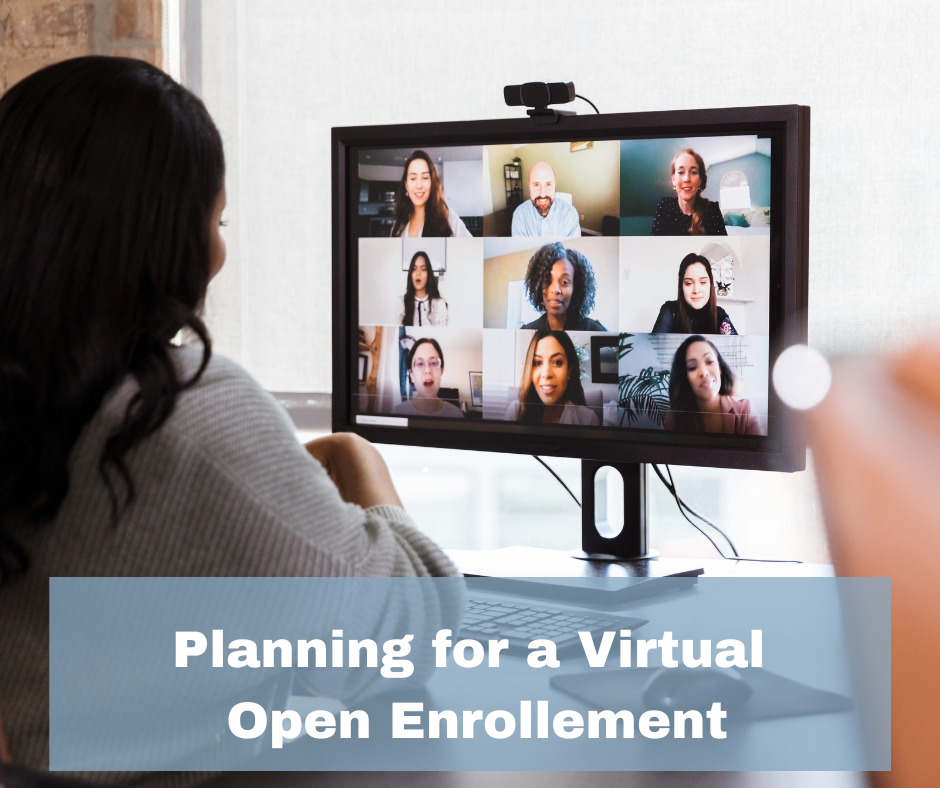Strategies for a Successful Virtual Open Enrollment

Why Virtual Open Enrollment?
In the wake of COVID-19, many organizations are allowing much of their staff work remotely to limit potential viral transmission. Plus, given that fall is the start of flu season, many organizations aren’t eager to pack employees back into the workplace if they can help it. This is why employers need an enrollment option that doesn’t necessitate in-person attendance.
That’s where virtual enrollment comes in. Virtual open enrollment is conducted entirely online, accessed by employees through their individual computers. The process will vary by enrollment platform, but the idea is the same: Provide educational materials and enable benefits selection within an online portal. In other words, employees would log into a website where they can download benefits summaries and make elections.
Virtual open enrollment is the ideal method for providing meaningful benefits to employees without risking potential viral transmission. What’s more, virtual open enrollment saves time and resources, since everything is done online. That means even clients with in-person staff can enjoy the advantages of a virtual enrollment process.
Tips for Facilitating a Virtual Open Enrollment
The following section provides best practices for how you can facilitate a successful virtual open enrollment.
Proactive Employee Outreach
Reach out to employees about their top benefits concerns. These may include benefits 101 education, available options, plan specifics or any number of subjects. These topics should influence what materials employees receive about enrollment. For instance, if many employees don’t seem to understand basic insurance terms, a glossary of terms should be included among their benefits handouts.
Define What Success Means to You
Open enrollment varies by organization, and virtual enrollment is no different. You should have a general idea of what “success” means to you, such as 100% on-time enrollment, for example. But objectives may be more nuanced, such as promoting a new plan type or receiving fewer employee questions related to health literacy. Work with your team and appropriate leadership to determine objectives ahead of time, in order to address any unique concerns.
Provide Ample Benefits Resources
Enrollment guides and benefits summaries are the meat and potatoes of any enrollment handout, but they shouldn’t be the only resources you provide. Consider the issues your employees have discussed previously, or reach out about current employee concerns. Then, make sure to include resources tailored to those concerns. This may involve sending physical materials to employees or placing the materials on the virtual enrollment platform for employees to access electronically.
Populate the Online Enrollment Portal
Before employees can enroll in their benefits, you must first ensure the virtual enrollment platform includes all the appropriate information. This means inputting plan information into the system as well as uploading any relevant benefits materials, such as enrollment guides, benefits summaries, insurance definitions, mandatory enrollment forms, disclosure documents and any other pertinent resources. Think of the virtual enrollment portal as the one-stop-shop for enrollment. Employees should be able to learn about their benefits and make their decisions without having to leave that website.
Draft Clear Open Enrollment Instructions
Enrollment won’t go smoothly if employees don’t know what to do. This is especially important for groups who may not be used to virtual open enrollment. Prior to enrollment, you should provide detailed instructions for your employees. They should outline the portal website, the resources it includes and steps for navigation. Walk through the portal yourself ahead of time. If necessary, set up time to walk through the portal with your Benefits Broker to ensure that all benefits have been set up accurately and to clarify the enrollment steps. It may be beneficial to record some video instructions for employees or to conduct a virtual tour via Skype or Zoom.
Follow Up Post-enrollment
After virtual open enrollment ends, follow up with employees to learn about their experiences. Ask them what went well and how they would like to improve next year. It will be important to perfect the virtual enrollment process, as it will likely be the standard within the next few years.

